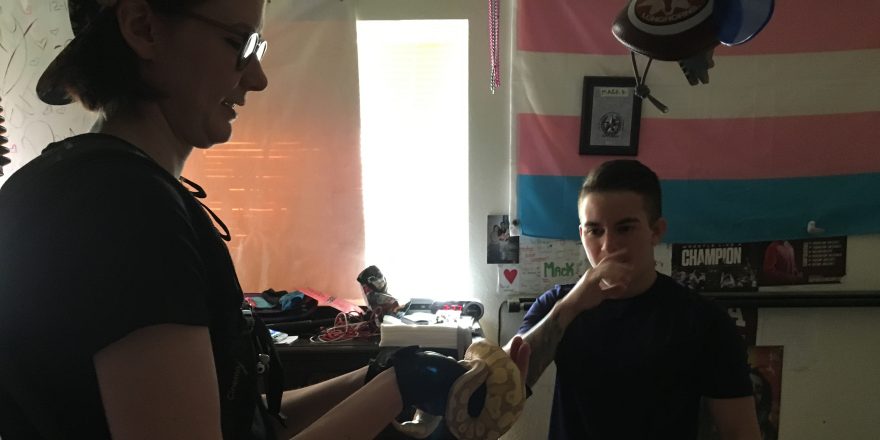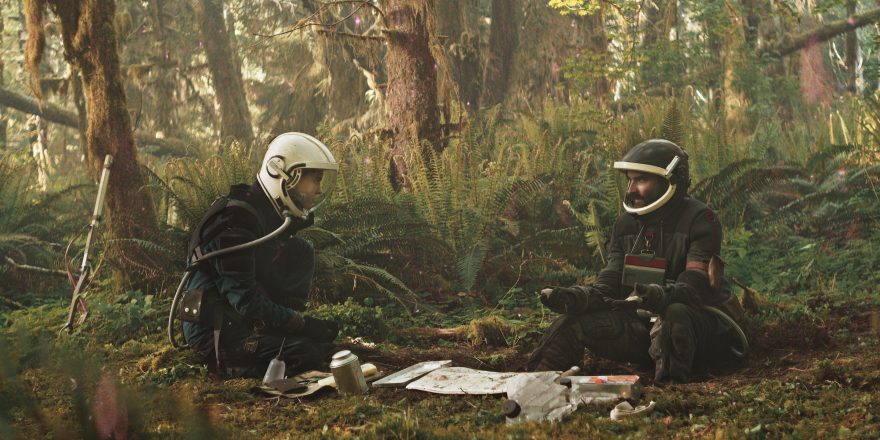I wrote the script for my new film Lapsis in early 2018, and as the producers Jesse Miller, Joseph Varca, Taylor Hess and I went about trying to raise money and get it off the ground, I imagined ours would be a good set. We had all worked on other films where we had either experienced or heard accounts of abuses small and large, public and private: more than anything, these situations often came down to the age-old tradition of paying people less and expecting them to do more, of hopeful beginnings yielding to grin-and-bear-it finishes.

In retrospect, my own hope to try to avoid these dynamics was nonspecific, reliant on a trust in myself as a good person, leading from above and knowing what I wanted to avoid. But then, in the fall of 2018, Taylor Hess and I co-directed a short documentary about a marine plastics laboratory in Newfoundland known as CLEAR (Civic Laboratory for Environmental Action Research), which practices feminist and anti-colonial science, focusing as much on methodologies of research and relations as they do on their field work and scientific analysis. Our time with CLEAR showed us how a group of people, aligned by a shared set of values, could actively deconstruct the entrenched power dynamics and models of hierarchy all around them – in this case, in academia. So hoping to avoid replicating the exploitative labor practices many of us had experienced before on non-union, low-budget filmmaking, we decided to try to adapt CLEAR’s Lab Book – which articulates their shared values, rules, and protocols – for use in the making of Lapsis.
One can be oriented towards wokeness and can consider oneself one of the “good ones.” But then the pressures of time and money tighten their grip on what seems possible, and low-budget filmmaking becomes – at least for some of the labor being done – no-budget filmmaking. Just recently, I watched a film festival Q&A where a director fondly recalled trading pizza for crew labor on the set of his latest feature. In a system where the writer-director – or if they’re not the same person, then the director – stands to benefit the most from the upward thrust of a successful independent film, landing them press interviews, festival appearances, and perhaps a manager and agent, I would argue that there is no film that should be made if the people benefitting the most from the outcome cannot raise enough money to pay a minimum wage to the people who stand to benefit the least from its success.

Lapsis takes aim at the gamification of labor, the ways in which tech monopolies have exploited the dreams of self-sufficiency sought by independent contractors in order to strip away basic protections and push workers to their limits. If a movie set is a microcosm of the world outside its boundaries, then just like the real world, great hypocrisies can easily exist in close proximity. Left unchecked, this film about the exploitation of workers in a new sector of the gig economy and the privilege of receiving a head start could have been made by exploited workers led by a privileged director. Why even make the film if the actual people engaged in making it are working inside a microcosm that is its direct contradiction?
Working with CLEAR gave us a conviction to judge the success of a project not just by its financial returns, critical acclaim, or the new opportunities it offered a few of us, but also by its lived ethics and its methods. It was crucial for us that the methods matched the message – that the way Lapsis was made was acutely aware of the modes of relations it was reproducing.

The filmmaking handbook that we adapted from CLEAR’s Lab Book established a series of foregrounded values and on-set guidelines that came to serve as a reference point for all of our onboarding during pre-production and our decisions during production. On our first day of shooting, we came together to discuss the handbook as a full group one last time before production officially started. Standing in a circle in a convention center in Poughkeepsie, we recalled CLEAR’s number one lab rule, which had become a guiding principle for us: If you’re tired, heartbroken or sick, you go home. There is no air given to the myth of the macho, lone-genius filmmaker with everyone else working at their whim. Concerns from any member of the crew were foregrounded, and our core value of accountability meant that stepping back and hoping someone else did something was not an option. In practice, this value resulted in the producers and myself spending one of our weekends during production reinforcing wooden bridges and dirt paths in the forest because of safety concerns that had been communicated to us from several crew members.
Lapsis also explores the thorny issue of automation: As more and more labor is rendered obsolete by robotics and A.I. platforms, who gets to decide where those profits go? On most films, the access to backend profit participation is decided by and reserved for “above the line” crew and key cast members. On Lapsis, we built in an “acquisition bonus” for all key crew above and beyond their fees, whereby the cinematographer, gaffer and boom operator, for example, all stand to make the same bonus if and when the film starts to turn a profit.

As much as we tried to enact the values of the handbook from pre-production through post, it wasn’t perfect by any means. The process is iterative, and on my next film I’ll hope we can work towards even more equitable relations and a stronger centering of the values espoused in the handbook. CLEAR’s protocols call for a value renewal process so as to stay responsive and relevant to the collective and the challenges of our time. Together with the other Lapsis producers, we recently gathered (on Zoom) to renew our values and update the filmmaking handbook used on Lapsis, now drawing from our shared experiences over the past two years. We made our new filmmaking handbook publicly available on our website, and it is free to be taken and used as-is by other filmmakers with Creative Commons attribution, always pointing back to the CLEAR lab as the original authors of the core methods and protocols involved. We urge interested groups to enact the methodology for themselves, thereby defining their own core values. In doing so, the status quo of how we make films and the relations we enact in the process can be interrogated, refreshed, and renewed, perhaps creating a microcosm that better reflects the world we would wish to see outside it.
Featured image shows writer-director Noah Hutton on the set of Lapsis with actor Ivory Aquino. (Image courtesy Noah Hutton.)







